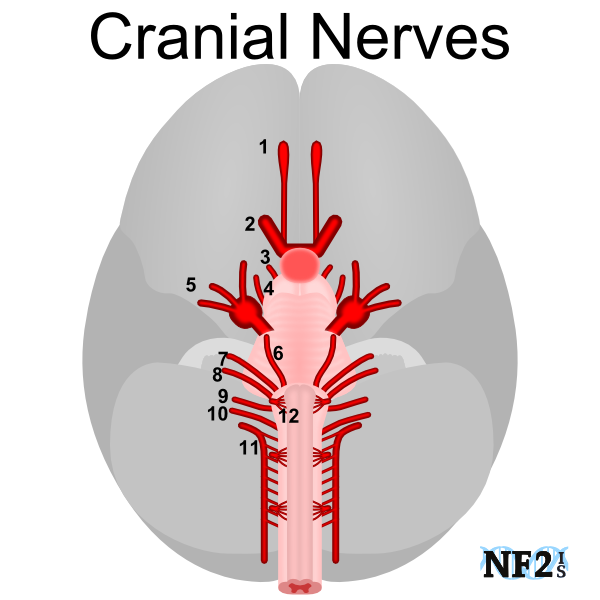Home >
Cranial Nerves
Last Updated: 08/4/20
Index
- Cranial Nerves: Basic Facts About
- Cranial Nerves: And NF2
- Cranial Nerves: Functions
- CN I: Olfactory Nerve
- CN II: Optic Nerve
- CN III: Oculomotor Nerve
- CN IV: Trochlear Nerve
- CN V: Trigeminal Nerve
- CN VI: Abducens Nerve
- CN VII: Facial Nerve
- CN VIII: Vestibulocochlear Nerve
- CN IX: Glossopharyngeal Nerve
- CN X: Vagus Nerve
- CN XI: Spinal Accessory Nerve
- CN XII: Hypoglossal Nerve
- Sourcs
Cranial Nerves: Basic Facts
A cranial nerve (CN) is any of the twelve (12) paired nerves that arise from the lower surface of the brain with one of each pair on each side and pass through openings in the skull to the periphery of the body. [1]
The twelve cranial nerves include; 1) olfactory nerve, 2) optic nerve, 3) oculomotor nerve, 3) trochlear nerve, 4) trigeminal nerve, 5) abducens nerve, 6) facial nerve, 7) vestibulocochlear nerve, 8) glossopharyngeal nerve, 9) vagus nerve, 10) spinal accessory nerve, 11) and hypoglossal nerve. [1]
Cranial Nerves: And NF2
For individual's with neurofibromatosis type 2 (NF2), schwannoma tumors grow as a part of up to eight (8) of the brains twelve (12) cranial nerves. Some individuals with NF2 only develop tumors on one pair of cranial nerves. Variations of how and when tumors develop vary from person to person.[3]
The hallmark location often used as part of the diagnosis criteria for individuals with NF2, are tumors along cranial nerve 8 (CN8), the vestibulocochlear nerve. The functions of CN8 are hearing and balance. Growth of tumors along CN8 can also damage CN7, the facial nerve. The function of CN7 is facial expression.
The complete list of cranial nerves individuals with NF2 commonly develop tumors on include:[4]
- CN3: oculomotor
- CN4: trochlear
- CN5: trigeminal
- CN6: abducens
- CN7: facial
- CN8: vestibulocochlear
- CN9: glossopharyngeal
- CN10: vagal
- CN11: spinal accessory
- CN12: hypoglossal
Cranial Nerves: Functions[1]
Each of the cranial nerves controls a specific function, sense, or sometimes both.
-
CN I (olfactory nerve): CN1 controls the olfactory bulb for the sense of smell
CNI (cranial nerve 1), is the only cranial nerve that can regenerate completely if damaged. -
CN II (optic nerve):
CN2 controls the lateral geniculate nucleus for vision
CNII (Cranial Nerve 2), carries vision to the brain. This nerve does not contain schwann cells. -
CN III (oculomotor nerve):
CN3 controls the oculomotor nucleus and edinger-westphal nucleus for the muscles of the eye
CN3, (cranial nerve 3) has two functions it controls:
- levator palpebrae superioris muscle: this muscle keeps the eyelids open
- construction of the pupils: adaption to changing light
-
CN IV (trochlear nerve):
CN4 controls the trochlear nucleus, muscles for eye movement
CN IV (cranial nerve 4), controls eyeball movement, rotating, up, down, left and right. -
CN V (trigeminal nerve), three (3) branches:
CN5 controls the mesencephalic nucleus, principal sensory nucleus, spinal trigeminal nucleus, and trigeminal motor nucleus.- ophthalmic nerve (V1): Muscles of the eyelids, eyebrow, forehead, and nose.
This branch affects the glands for tear production and mucous membrane of the nasal cavity. - maxillary nerve (V2): Sensation from the maxillary, nasal cavity, sinuses and taste.
- mandibular nerve (V3): Face sensations and muscles for biting, chewing, and swallowing.
- ophthalmic nerve (V1): Muscles of the eyelids, eyebrow, forehead, and nose.
-
CN VI (abducens nerve):
CN6 controls the abducens nucleus for eye movement.
lateral rectus muscle: lateral vision -
CN VII (facial nerve):
CN7 controls the facial motor nucleus, superior salivatory nucleus, and solitary nucleus.
- muscle control: facial expression
- sensory control: taste sensations for the front 2/3 of the tongue; sensations of sweet and salty
-
CN VIII (vestibulocochlear nerve):
CN8 controls the vestibular nuclei (w. subnuclei) and cochlear nucleus (w. subnuclei).
- cochlear nerve: hearing
- vestibular nerve: balance
-
CN IX (glossopharyngeal nerve):
CN9 controls the solitary nucleus, the spinal nucleus of the trigeminal nerve, lateral nucleus of
vagal trigone, nucleus ambiguus, and inferior salivatory nucleus for muscles of the tongue,
tonsil, and pharynx.
- muscle control: Control of the stylopharyngeus muscle, impairment of this muscles can affect swallowing and speech.
- sensory control: Taste sensations from the back 1/3 of the tongue; sensations of bitter and sour.
-
CN X (vagus nerve):
CN10 controls the dorsal nucleus of vagus nerve, nucleus ambiguus, solitary nucleus, and spinal
trigeminal nucleus.
- muscle control: Muscle control that controls heart rate, sweating, esophagus, and digestion, as well as many involuntary muscle movements in the mouth, including speech, and breathing.
- sensory control: Feeling in the ear canal.
- CN XI (spinal accessory nerve): CN11 controls the spinal accessory nucleus, and nucleus ambiguus for muscles used in neck and shoulder movement.
- CN XII (hypoglossal nerve): CN12 controls the hypoglossal nucleus for muscles of the tongue.
4. Sources
- Merriam-Webster Definitions. (Last Accessed: October 2020) https://www.merriam-webster.com/
- Medical-Dictionary - TheFreeDictionary (Last Accessed: October 2020) https://medical-dictionary.thefreedictionary.com/
-
Deora, Harsh, et al. "Rare cranial nerve schwannomas: A retrospective review of nontrigeminal, nonvestibular cranial nerve schwannomas."
Journal of Neurosciences in Rural Practice 9.2 (2018): 258
https://www.thieme-connect.com/products/ejournals/html/10.4103/jnrp.jnrp_469_17 -
Widemann, B. C., Acosta, M. T., Ammoun, S., Belzberg, A. J., Bernards, A., Blakeley, J., ... & Morrison, H. (2014).
"CTF meeting 2012: Translation of the basic understanding of the biology and genetics of NF1, NF2, and schwannomatosis
toward the development of effective therapies." American Journal of Medical Genetics Part A, 164(3), 563-578.
http://onlinelibrary.wiley.com/doi/10.1002/ajmg.a.36312/full -
"Cranial Nerves: Brief Overview of Cranial Nerves." Lumen Learning
https://courses.lumenlearning.com/boundless-ap/chapter/cranial-nerves/



 |Google Play
|Google Play